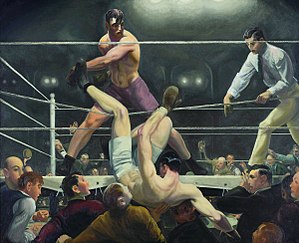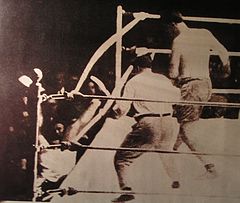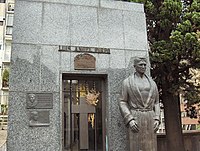Jack Dempsey vs. Luis Ángel Firpo
 Firpo sending Dempsey outside the ring; painting by George Bellows | |||||||||||||||||||||||||
| Date | September 14, 1923 | ||||||||||||||||||||||||
|---|---|---|---|---|---|---|---|---|---|---|---|---|---|---|---|---|---|---|---|---|---|---|---|---|---|
| Venue | Polo Grounds, New York City | ||||||||||||||||||||||||
| Title(s) on the line | NYSAC, NBA, and The Ring heavyweight titles | ||||||||||||||||||||||||
| Tale of the tape | |||||||||||||||||||||||||
| |||||||||||||||||||||||||
| Result | |||||||||||||||||||||||||
| Dempsey wins via 2nd-round KO | |||||||||||||||||||||||||
Jack Dempsey vs. Luis Ángel Firpo was a boxing match and one of the most significant events in sports of the era. It was the first time that a Latin American challenged for the world heavyweight title. The bout was named Ring Magazine Fight of the Year for 1923. The painting Dempsey and Firpo by George Bellows, showing Firpo knocking Dempsey out of the ring, is an iconic piece of Americana.
Background[edit]
Firpo was the first Latin American in history to challenge for the world heavyweight title. He burst onto the scene in 1922. None of the results of his from before 1922 were available to most audiences. After going 4–0 in 1922, Firpo began 1923 at Madison Square Garden knocking out former title challenger Bill Brennan in the 12th round with a right. Brennan had to be taken to the hospital afterwards for a concussion. "Dempsey never hit me any harder than this fellow," said Brennan. Adding that he couldn't wear his old hat because his head was too swollen.[1] Firpo knocked out former heavyweight champion Jess Willard in front of 100,000 spectators, a world record for boxing attendance at the time.[2] Finally getting the title shot after a win against Charley Weinert.
In anticipation for the Dempsey-Firpo bout, a Firpo sparring session drew a crowd of 12,000.[3] The match was at the Polo Grounds, normal capacity 55,000, but an additional 20,000 seats were constructed bringing the total to 75,000 for the fight,[4] later expanded to 83,000. The police estimated that 150,000 people showed up, including a mass extending a quarter mile in every direction around the arena.[5]
The event[edit]
Dempsey versus Firpo took place on September 14, 1923, at the Polo Grounds in New York City. Dempsey had been champion since 1919, and Firpo was one of the top heavyweights of the world, nicknamed "El Toro de las Pampas" ("The Wild Bull of the Pampas"). The referee was Johnny Gallagher.[6]

Firpo was floored seven times in the first round of the bout, before he trapped Dempsey against the ropes and launched a combination that sent the champion out of the ring. Dempsey was helped into the ring at the count of nine (in spite of having been seventeen seconds outside the ring; fighters are given a twenty-second count when they are knocked through the ropes). After getting back in the ring Dempsey took 13 consecutive shots from Firpo.[7] In the second round Dempsey rallied and knocked out Firpo. It was named Ring Magazine Fight of the Year for 1923.
Controversies[edit]
Years later Gene Tunney would say in Esquire, "the Dempsey-Firpo fight was the most controversial in boxing history." Tunney attributed the result to Firpo not having a manager. "After Dempsey had been out of the ring ten seconds, any manager would have been in there, raising Firpo's hand and claiming the championship."[8]
When Dempsey was knocked out of the ring, reporters at ringside helped him back in, a violation of the rules. Years later Dempsey would say "I was down, and if it wasn’t for the public throwing me back in there, I would have never gotten back into the ring." At the time of the fight The New York Times reported that news had falsely spread to Buenos Aires that Dempsey had been disqualified.[9]
Dempsey was permitted to stand over the fallen Firpo and immediately knock him down again, as there was yet no rule about going to a neutral corner. The referee, Johnny Gallagher, was still supposed to prevent the fighter from scoring the knockdown by standing directly over his floored opponent. In the aftermath of the fight, Gallagher was suspended after an investigation and never refereed again.[10] 2 months after the fight, the New York Boxing Commission adopted the neutral corner rule.[11]
The aftermath[edit]
Dempsey and Firpo both became icons. Dempsey later lost his Heavyweight title to Gene Tunney in two equally historic bouts (see: The Long Count Fight). He served in the military and opened a restaurant in New York before his death in 1983.
Firpo's popularity around Latin America was immeasurable. Years later, C.D. Luis Ángel Firpo, a professional football team in El Salvador was named after him. In addition, various schools, streets, and avenues across Latin America have been named after him.[12]

Argentine boxer Oscar Bonavena also fought two great heavyweight champions, losing to Muhammad Ali and Joe Frazier, the latter for the NYSAC's version of the world heavyweight title. Ultimately, John Ruiz, an American of Puerto Rican descent, became the first boxer of Hispanic and of Latin American descent to win the world Heavyweight title, beating Evander Holyfield in 2001 for the World Boxing Association's version of the title.
Firpo died a wealthy man in 1960. His body rests in the La Recoleta Cemetery in Buenos Aires.
In popular culture[edit]
In 1923–1924, George Bellows painted Dempsey and Firpo, depicting Firpo dropping Dempsey through the ring's ropes on their historic fight. (Although the painting seems to depict Firpo hitting Dempsey with a left, this is in fact the follow-through after Firpo's right sent Dempsey through the ropes.) In 1950, Firpo's second knockdown of Dempsey was named "the most dramatic sports moment of the (20th) century so far".
Quirino Cristiani adapted the fight in an animated short, Firpo-Dempsey (1923).[13]
This is the fight where Clark Gable's and William Powell's characters meet in the 1934 movie Manhattan Melodrama.
In 1935, the New York Daily News asked five prominent fighters and others involved in boxing to name the greatest ring battle they ever saw. Three of them- light-heavyweight champion Bob Olin, trainer Doc Robb and Madison Square Garden announcer Clem White- responded with the Dempsey-Firpo fight.[14]
In the play Twelve Angry Men, the seventh juror (a sports fan who believes the accused is guilty) suggests to his fellow jurors that if juror No. 8 had been "ringside at the Dempsey-Firpo fight, he'd be tryin' to tell us Firpo won" because juror No. 8 is trying to convince the other 11 jurors that the accused may not be guilty. In the 1957 movie version by Sidney Lumet, the fight is also mentioned the same way, though juror No. 7's line is cut short, only managing to say that if juror No. 8 had been "ringside at the Dempsey-Firpo fight, he'd be tryin' to tell us..." before trailing off and moving on to his next line.
In the 1957 movie The Spirit of St. Louis, Charles Lindbergh (portrayed by Jimmy Stewart) receives two film canisters, marked “Dempsey" and "Firpo.”
The fight was mentioned in Steve McQueen's The Sand Pebbles (1966) during the fight between Po-han and Ski.
The fight is referenced in the 1976 film Rocky by character Mickey Goldmill, who says he fought an opponent on the same date. Moreover, challenger Rocky Balboa floors champion Apollo Creed at the very start of the fight, just as Firpo did to Dempsey.
In the M*A*S*H episode "Tea and Empathy," a patient says to Dr. B.J. Hunnicutt, "Hey Doc, remember me?" Hunnicut replies, "Yeah, sure. I sat next to you at the Dempsey-Firpo fight".[15]
The fight is mentioned in Julio Cortázar's short story Circe[16]
References[edit]
- ^ "BRENNAN SUFFERS BRAIN CONCUSSION: Taken to Hospital Following Knockout by Firpo -- "Rabbit Punch" Is Blamed. HIS CONDITION NOT SERIOUS Blow Which Caused Injury Was a Sledgehammer Right Be- hind the Left Ear. TOOK AN AWFUL BEATING" Physician Says Boxer Shows Signs of Battering -- Firpo Hits Hard as Dempsey, Asserts Victim". The New York Times. 15 March 1923. Retrieved 5 October 2023.
- ^ "MOB FIGHTS FOR TICKETS: Crowd Seeking $3.30 Admissions Sweep Police Aside in Rush WOMEN HURT IN CRUSH Many Injuries Reported in Ef- fort to Restore Order Outside the Polo Grounds. FANS BAIT SPECULATORS Police Arrest Twelve Men Charged With Profiteering in Tickets. MOB FIGHTS FOR TICKETS". The New York Times. 15 September 1923. Retrieved 6 October 2023.
- ^ "FIRPO DRAWS 12,000 TO SEASIDE CAMP: Big Holiday Crowd Watches Luis in Six Rounds of Lively Sparring. LEFT HAND STILL USELESS Right His Only Effective Weapon, as Before, and With It He Bursts Punching Bag In One Swing". The New York Times. 4 September 1923. Retrieved 6 October 2023.
- ^ "BOXING LOOMS UP AS BIG BUSINESS: QUICK WAY TO GET RICH $500,000 to Dempsey for His Match With Firpo FEW DOLLARS ONCE A PURSE $10,000,000 Estimated Receipts This Year in New York State Alone Sets High Mark". The New York Times. 9 September 1923. Retrieved 6 October 2023.
- ^ "MOB FIGHTS FOR TICKETS: Crowd Seeking $3.30 Admissions Sweep Police Aside in Rush WOMEN HURT IN CRUSH Many Injuries Reported in Ef- fort to Restore Order Outside the Polo Grounds. FANS BAIT SPECULATORS Police Arrest Twelve Men Charged With Profiteering in Tickets. MOB FIGHTS FOR TICKETS". The New York Times. 15 September 1923. Retrieved 6 October 2023.
- ^ New York Daily News, September 15, 1923, p.3
- ^ "FIRPO FELLED TEN TIMES: Champion Downed Twice and Punched Through Ropes at Outset". The New York Times. 15 September 1923. Retrieved 6 October 2023.
- ^ Tunney, Gene (October 1958). "A Champion On Champions". Esquire. Archived from the original on 1 March 2004. Retrieved 10 March 2016 – via genetunney.org.
- ^ Cassidy, Robert. "100 years ago, the Jack Dempsey-Luis Angel Firpo fight made New York the capital of boxing". newsday.com. Retrieved 10 October 2023.
- ^ Franklin, Bobby. "Dempsey Vs Firpo 100 Years Later: Was It Really A Legendary Fight?". Retrieved 10 October 2023.
- ^ "KNOCKDOWN RULE ADOPTED BY BOARD: Commission Instructs Referees to Send Boxer Flooring Opponent to Neutral Corner. BELL TO DENOTE KNOCKOUT Two Gongs Will Mean Man Has Been Counted Out -- One to Signify Round Is Over". The New York Times. Retrieved 11 November 2023 – via ProQuest.
- ^ "PUTS FIRPO BEFORE AN ARGENTINE PATRIOT: Town Names a Street for Pugilist, Mayor Thinking Lopez Was a Tax Collector". The New York Times. 31 January 1924. Retrieved 6 October 2023.
- ^ Bendazzi, Giannalberto (6 November 2017). Twice the First: Quirino Cristiani and the Animated Feature Film. ISBN 9781351371797 – via Google Books.
- ^ "The Inquiring Photographer". New York Daily News. 8 October 1935.
- ^ "M*A*S*H (MASH) Y109 Episode Script".
- ^ "Cuando Firpo tiró a Dempsey". Conclusión – Diario Digital Rosario (in European Spanish). Retrieved 2018-04-23.
External links[edit]
- Un KO di 17 secondi (IT) – Dempsey vs. Firpo, un "match" indimenticabile
- The fight
